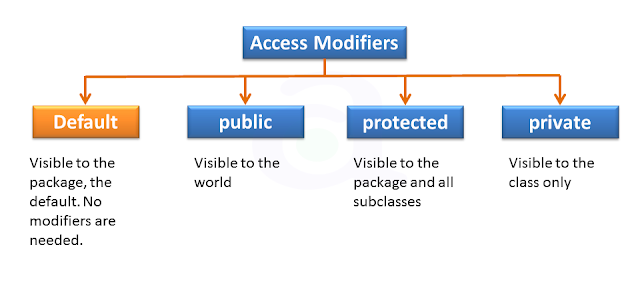Private vs Public vs Protected vs Package in Java
Java has
four access modifiers: private, protected and public. Packet-level access is
the default access level provided by Java if no access modifier is specified.
These access modifiers are used to restrict the accessibility of a class,
method or variable in which it is applied. Let's start with the private access
modifier which is the most restrictive access modifier and then go to the
public that is the least restrictive access modifier, along the way we will see
some best practices while using the access modifier in Java and some examples
of use of private and protected keywords.
Private keyword in Java
Keyword or private
modifier in Java can be applied to the member, method or class nested in Java.
You cannot use the private switch in the top-level class. The variables,
methods and particular classes are accessible only in the class in which they
are declared. Private is the highest form of Java encapsulation API and should
be used as much as possible. It is best practice to encode in Java declare
private variable by default. A private method can only call the class in which
it was declared.
According to the rules
of method substitution in Java, a private method cannot be replaced either. The
private keyword can also be applied to the constructor and, if it becomes the
private constructor, it will prevent it from being subclassified. A popular
example of making the private constructor is the Singleton class in Java, which
provides the getInstance () method to get the object instead of creating a new
object using the Java constructor. Here are some differences between private
and protected access, the public and the package level
Package
or default access level in Java
There is no access
modifier called package, instead, the package is a keyword that is used to
declare a package in Java, a package is a directory in which a Java class
belongs. The standard or packet access level is the second highest restricted
access modifier after private and any variable, method or class declared as
private-package is accessible only in the package to which it belongs. The good
thing about the standard modifier is that the top-level class can also be
private for the packet if there is no access switch at the class level.
Protected
keyword in Java
The difference between
the private and protected keyword is which protected method, variable or nested
class is not only accessible within a class within the package, but also
outside the package in a subclass. If you declare a protected variable, anyone
can use it if you extend your class. The top-level class can not be protected
as well.
Public
keyword in Java
Public is the least
restrictive access modifier in the Java programming language and its bad practice
is to declare field, method or class by default public because, once made
public, it is very difficult to make any change in the internal structure of
the class, because affects all customers. this. Making the class or instance
variable public also violated the encapsulation principle, which is not good at
all and greatly affects maintenance. Instead of making variable public, you
should make it private and provide public getter and setter. The public
modifier can also be applied to a top-level class. In Java, the file name must
be the same with the public class declared in the file.
This is all the
difference between the private, protected, package and public access modifier.
As you saw, the difference between private and public resides in how accessible
a particular field, method or class would be. Public means that you can access
it anywhere, while private means you can only access it within your own class.
Just to observe that
all private, protected or public modifiers are not applied to local variables
in Java, a local variable can only be final in java.
To getting expert-level training for Java Training in your location
– java training in chennai | java training in bangalore | java training in pune | java training in chennai | java training in bangalore | java training in tambaram | java training in omr | java training in velachery | java training in annanagar | java training in chennai | java training in marathahalli | java training in btm layout | java training in jayanagar | For getting java online
training | java online training





No comments:
Post a Comment